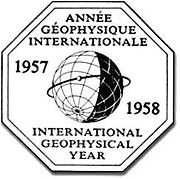
Back السنة الجيوفيزيائية الدولية Arabic Añu Xeofísicu Internacional AST Any Geofísic Internacional Catalan Mezinárodní geofyzikální rok Czech Internationales Geophysikalisches Jahr German Διεθνές Γεωφυσικό Έτος Greek Internacia Geofizika Jaro Esperanto Año Geofísico Internacional Spanish Rahvusvaheline geofüüsika aasta Estonian Nazioarteko Geofisika Urtea Basque

The International Geophysical Year (IGY; French: Année géophysique internationale), also referred to as the third International Polar Year, was an international scientific project that lasted from 1 July 1957 to 31 December 1958. It marked the end of a long period during the Cold War when scientific interchange between East and West had been seriously interrupted. Sixty-seven countries participated in IGY projects, although one notable exception was the mainland People's Republic of China, which was protesting against the participation of the Republic of China (Taiwan). East and West agreed to nominate the Belgian Marcel Nicolet as secretary general of the associated international organization.[1][2]

The IGY encompassed fourteen Earth science disciplines: aurora, airglow, cosmic rays, geomagnetism, gravity, ionospheric physics, longitude and latitude determinations (precision mapping), meteorology, oceanography, nuclear radiation, glaciology, seismology, rockets and satellites, and solar activity.[3] The timing of the IGY was particularly suited for studying some of these phenomena, since it covered the peak of solar cycle 19.
Both the Soviet Union and the U.S. launched artificial satellites for this event; the Soviet Union's Sputnik 1, launched on October 4, 1957, was the first successful artificial satellite.[4] Other significant achievements of the IGY included the discovery of the Van Allen radiation belts by Explorer 1 and mid-ocean submarine ridges, an important confirmation of plate-tectonic theory.[5][6][7] Also, many international bases were established in Antarctica, many of which have been maintained to the present day, including at the south pole.
- ^ "Rockets, Radar, and Computers: The International Geophysical Year". NOAA Celebrates 200 Years. 24 October 2022. Retrieved 22 August 2023.
- ^ Everts, Sarah (2016). "Information Overload". Distillations. 2 (2): 26–33. Retrieved 20 March 2018.
- ^ CSAGI Guide to the IGY World Data Centers (1959) Annals of the International Geophysical Year Vol 7 Part 2 Pergamon Press
- ^ "International GeoPhysical Year".
- ^ "IGY History". ESRL Global Monitoring Division. Archived from the original on 17 May 2008. Retrieved 14 August 2015.
- ^ WMO, Archives. "The International Geophysical Year, 1957–1958". Archived from the original on 2016-07-02. Retrieved 2016-06-29.
- ^ "Korolev, Sputnik, and The International Geophysical Year".